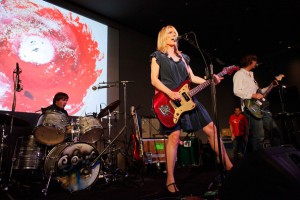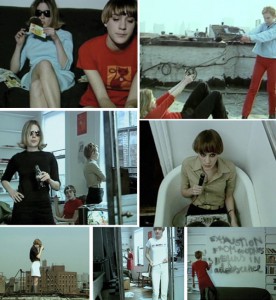Kim Gordon’s Self-Fashioning
 In her memoir, Girl in a Band (Dey Street Books, 2015), Kim Gordon recalls a photo shoot with photographer Michael Lavine for Daydream Nation, her band Sonic Youth’s 1988 breakthrough album. “‘Do you want to look cool, or do you want to look attractive?’ Michael asked me, as if the two were mutually exclusive. The silver paint; glitter-dabbed, faded cutout jeans; and crop top with the sheer jeweled panel marked a turning point for me and my look. I decided I didn’t want to just look cool, or just look rock and roll: I wanted to look more girl” (161).
In her memoir, Girl in a Band (Dey Street Books, 2015), Kim Gordon recalls a photo shoot with photographer Michael Lavine for Daydream Nation, her band Sonic Youth’s 1988 breakthrough album. “‘Do you want to look cool, or do you want to look attractive?’ Michael asked me, as if the two were mutually exclusive. The silver paint; glitter-dabbed, faded cutout jeans; and crop top with the sheer jeweled panel marked a turning point for me and my look. I decided I didn’t want to just look cool, or just look rock and roll: I wanted to look more girl” (161).
This quote supports the conviction that girlhood and its artefacts are resources for feminist media production and critique. It’s a foundational argument advanced by Angela McRobbie, Mary Celeste Kearney, and other feminist scholars who work within cultural studies, a discipline that investigates the ambivalent politics of everyday life through subjects’ engagement with popular media. Alongside figures like Kathleen Hanna and Wendy Mullin, Gordon’s reclamation of girlhood and girlishness speaks to her connections with riot grrrl and third-wave feminism, movements that deconstructed visual signifiers attached to various feminine archetypes—the flapper’s bejeweled accessories, the housewife’s shirtwaist dress, the Girl Scout’s jumper, the mod’s miniskirt—to question womanhood’s regulations.
As a musician, Gordon challenged rock’s hegemonic masculinity as the unassumingly female and deliberately “feminine” presence within Sonic Youth’s all-male line-up. For one, her deadpan singing and conceptual songwriting frequently voiced women’s concerns about anorexia, harassment, mother-daughter relations, essentialism, commodification, and desire’s sharp edges. Gordon, born on the West Coast to an academic family and bestowed with an art-school education, shares these traits with Pet Shop Boys’ frontman Neil Tennant, who used the grammar of disco to illuminate the politics of the closet for upper-middle-class Englishmen during the AIDS epidemic only to be accused of “just” talking over a beat. As a result, Gordon fought for legitimacy, first through her parenthetical approach to playing bass and later by shredding with guitarists Lee Ranaldo and Thurston Moore, two players of a connotatively male instrument that she once memorably described in a tour diary as “thunderfoxes in the throes of self-love and combat.” Finally, her relationship with Moore frequently served as evidence that feminism preserved marriages between creative professionals.
Plenty of attention has already been paid toward Gordon and Moore’s divorce and its impact on Sonic Youth’s demise, which Girl uses as a framing device. Gordon writes about the disillusion with withering, Didion-eseque brevity as “just another cliché of middle-aged relationship failure—a male midlife crisis, another woman, a double life” during an account of the band’s final concert at the 2011 SWU Music and Arts Festival that opens the book (3). She concludes by detailing the prolonged betrayal of Moore’s affair, deep, fresh reserves of anger lacerating her prose as she recalls announcing the separation to their daughter, Coco, at the beginning of her senior year of high school.
A recurring theme in Gordon’s memoir is her frustration with the cycle of questions she has been asked throughout her career. One informs its title (as in: “what’s it like to be a girl in a band?”). Another—variations on “can women have it all?”—haunted Gordon as journalists fixated on their normative impressions of her identities as a wife and mother. Focusing on the end of her marriage and band would seem to be the root for more oft-repeated, dead-end questions to a woman who continues to make music and art. Therefore, it’s notable that in the middle of Girl, Gordon observes that X-Girl, a skater-themed clothing line she ran with Daisy Von Furth in the mid-90s, “gave me far more notoriety than Sonic Youth ever did” (199).
Vulture’s Lindsay Zoladz observes that Gordon’s oblique approach to songwriting informs her storytelling as a memoirist. As a result, Gordon does not elaborate upon her foray into women’s apparel, nor contextualize it alongside her subsequent collections with Urban Outfitters and Surface to Air. She also tethers X-Girl to familial obligations—she was pregnant throughout its first year of production, she used the money she made from selling it to Japanese company B’s International to purchase her family’s home in Northampton.
However, part of Gordon’s contribution to rock music—what makes her the “Jet Set” in Sonic Youth’s 1994 album, Experimental Jet Set Trash and No Star—is her attention to womanly self-fashioning. The frisson between gender performance and pop culture’s absorption into everyday life is central to Gordon’s image, a point Pitchfork contributor Molly Beauchemin makes in her piece on female rock musicians’ Instagram profiles. It’s how the X-Girl logo appeared on DJ Tanner’s long-sleeve t-shirt in a late-season Full House episode, and why I recognized it from reading Seventeen before I could identify the opening chords to “Kool Thing” or Gordon’s menacing whisper.
Thus, Girl presents a question: why might fashion design matter to recording industry professionals? Ever the bricoleur, Gordon decorates her prose with collages of various style icons—Jane Birkin’s louche bohemianism, Françoise Hardy’s urban coquettishness, her mother’s post-Beat utilitarianism, the clean lines of prep school attire she hated as a teenager but revised with mod’s graphic impact and punk’s lean androgyny for X-Girl. Such references bear some resemblance to what Caitlin Yunuen Lewis describes in her star study of Sofia Coppola as “cool postfeminism,” a cultural phenomenon where articulations of “white femininity’s ideals have become ironic and marketable, as have its ‘darker’ opposites, the sexual and moral transgressions that were once most threatening to it” (195). At the very least, it offers a term to describe how Gordon applies and discards certain ethnic sartorial traditions or uses “tranny” to describe designer Patricia Field’s aesthetic. But Gordon’s quotations read as influences in the same way musicians talk about their favorite records and gear. At least they could, if Gordon were asked to discuss her interest in fashion and music as mutually constitutive outlets for creative expression. By elliptically recalling her life’s events, she raises such questions for others to ask.




